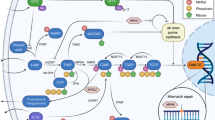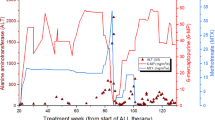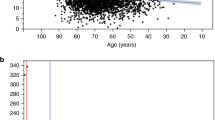Abstract
The cytotoxic activity of 6-mercaptopurine (6-MP) is affected by thiopurine methyltransferase (TPMT), a genetically regulated and variable intracellular enzyme. 6-Thioguanine (6-TG), a closely related thiopurine, is less affected by that enzyme and so it may be a more reliable drug-at least for patients with constitutionally high TPMT activity. We attempted to assess its suitability as an alternative by comparing the pharmacokinetics of both drugs in a small group of children with lymphoblastic leukaemia (ALL). Patients were included who were in their second or subsequent remission, who would otherwise have received 6-MP, and on whom pharmacokinetic data concerning 6-MP metabolism had been collected in a previous remission. Plasma 6-TG concentrations were assayed following an oral dose of 40 mg m-2, and the accumulation and fluctuation of intracellular (erythrocyte, RBC) 6-TG nucleotides (6-TGNs) were measured at regular intervals during daily oral therapy. Seven children were studied. Plasma 6-TG concentrations were low and cleared within 6 h of oral dosing. At 7 days, 6-TGN concentrations ranged from 959 to 2361 pmol 8 x 10(-8) RBCs, in all cases significantly higher (P = 0.002) than those produced by the same patients on 6-MP. After a total therapy time of 35 patient months, a modest rise of alanine aminotransferase was seen on one occasion, otherwise no toxicity apart from myelosuppression was encountered. In the context used, 6-TG appears well tolerated and produces higher concentrations of intracellular cytotoxic metabolites than 6-MP. For children constitutionally 'resistant' to the traditional drug, if not all, it may be a preferable alternative.
This is a preview of subscription content, access via your institution
Access options
Subscribe to this journal
Receive 24 print issues and online access
$259.00 per year
only $10.79 per issue
Buy this article
- Purchase on Springer Link
- Instant access to full article PDF
Prices may be subject to local taxes which are calculated during checkout
Similar content being viewed by others
Author information
Authors and Affiliations
Rights and permissions
About this article
Cite this article
Lennard, L., Davies, H. & Lilleyman, J. Is 6-thioguanine more appropriate than 6-mercaptopurine for children with acute lymphoblastic leukaemia?. Br J Cancer 68, 186–190 (1993). https://doi.org/10.1038/bjc.1993.311
Issue Date:
DOI: https://doi.org/10.1038/bjc.1993.311
This article is cited by
-
Advances in Thiopurine Drug Delivery: The Current State-of-the-Art
European Journal of Drug Metabolism and Pharmacokinetics (2021)
-
Clinical Pharmacokinetic and Pharmacodynamic Considerations in the Treatment of Inflammatory Bowel Disease
Clinical Pharmacokinetics (2018)
-
The improvement of anti-proliferation activity against breast cancer cell line of thioguanine by gold nanoparticles
Medicinal Chemistry Research (2013)
-
Drug Insight: pharmacology and toxicity of thiopurine therapy in patients with IBD
Nature Clinical Practice Gastroenterology & Hepatology (2007)
-
The thiopurines: An update
Investigational New Drugs (2005)



